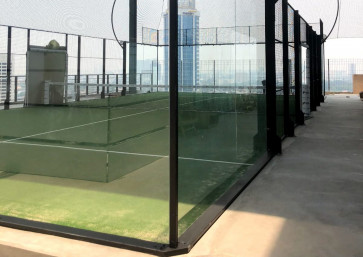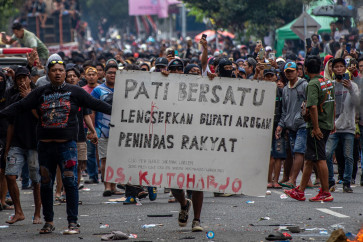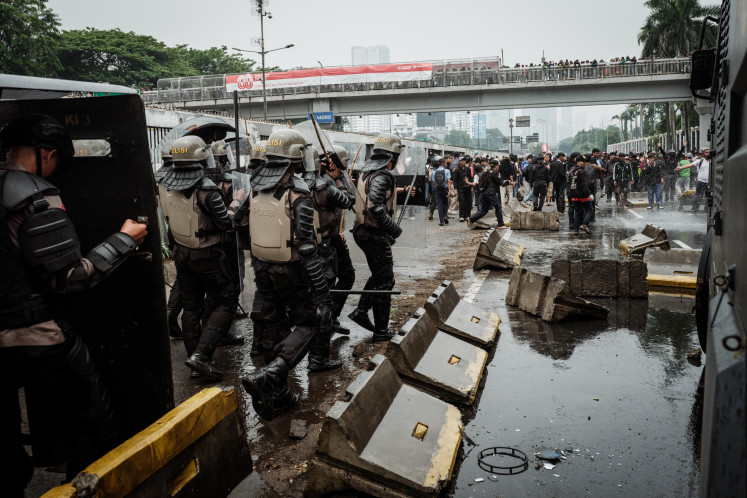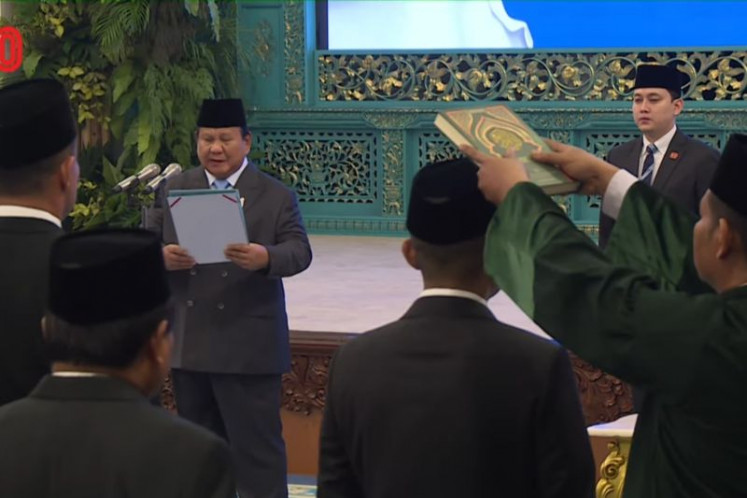Popular Reads
Top Results
Can't find what you're looking for?
View all search resultsPopular Reads
Top Results
Can't find what you're looking for?
View all search resultsTNI beefs up joint ops capability
Forces in unity: Indonesian Military (TNI) personnel from the three armed services — the Army, the Navy and the Air Force — march in a massed band at a parade rehearsal at the Halim Perdanakusuma Air Base in East Jakarta on Thursday, ahead of the 74th TNI anniversary on Saturday
Change text size
Gift Premium Articles
to Anyone
F
orces in unity: Indonesian Military (TNI) personnel from the three armed services — the Army, the Navy and the Air Force — march in a massed band at a parade rehearsal at the Halim Perdanakusuma Air Base in East Jakarta on Thursday, ahead of the 74th TNI anniversary on Saturday.(JP/Rafaela Chandra)
Ahead of its 74th anniversary on Saturday, the Indonesian Military (TNI) has taken what experts say is a big step toward addressing many of its current problems by forming three Joint Defense Regional Commands (Kogabwilhan).
It is hoped the three commands — based in Tanjung Pinang, Riau Islands; Balikpapan, East Kalimantan; and Biak, Papua — will help modernize and improve interbranch coordination, as well as help solve the problem of high-ranking officer overstaffing that has plagued the TNI.
TNI commander Air Chief Marshal Hadi Tjahjanto inaugurated the three Kogabwilhan commanders during a ceremony at Halim Perdanakusuma Air Base in East Jakarta last week.
Rear Adm. Yudo Margono was appointed as the commander of Kogabwilhan I in Tanjung Pinang, Air Vice Marshal Fadjar Prasetyo the commander of Kogabwilhan II in Balikpapan and Maj. Gen. Ganip Warsito the commander of Kogabwilhan III in Biak.
The three officers’ appointments as Kogabwilhan commanders is a promotion, as the position is a three-star post.
At the ceremony, Hadi said the establishment of the Kogabwilhan was part of an effort to strengthen the TNI and to provide a deterrence to outside threats.
"The Kogabwilhan were formed for a number of different reasons," Hadi said at the ceremony, as quoted by Antara. "We all know that recent developments are making the strategic environment more and more complex in terms of both military and nonmilitary threats. These threats need to be anticipated and studied."
Hadi said the commands would oversee all three branches of the TNI — the Army, the Navy and the Air Force — and that each of the three Kogabwilhan were placed to address specific threats.
Kogabwilhan I will defend against threats from the Malacca Strait and the North Natuna Sea, while Kogabwilhan II will help with the defense of the site of the new capital city, which borders Balikpapan.
“While Kogabwilhan III will secure the borders of Papua, including the surrounding waters," Hadi said.
University of Indonesia military expert Andi Widjajanto said the idea of forming the Kogabwilhan was not new, having been planned since the administration of former president Susilo Bambang Yudhoyono.
"The creation of the Kogabwilhan brings the military more in line with the 2004 TNI Law, which mandates the TNI's deployment to fit Indonesia's geography," he told The Jakarta Post on Friday. "The military now has three theaters of operation."
He said the most significant breakthrough the Kogabwilhan would achieve was an increase in the cohesiveness of the three branches of the military in various regions.
Before the formation of the joint commands, each branch's regional command had its own separate chains of command, which hindered coordination for joint military operations.
"With the Kogabwilhan, the TNI headquarters will build interoperability between the branches," Andi said.
However, he acknowledged that achieving such interoperability would require more advanced technology to keep the military at the cutting edge.
"Communications technology is needed in particular, so that tanks, for example, can communicate with submarines and jet fighters," he said.
A fortunate side effect, Andi said, was that the Kogabwilhan would also help mitigate the ongoing overstaffing issues that left middle and high-ranking officers without jobs.
"The Kogabwilhan will create positions for about 30 general officers and hundreds of colonels, which will help significantly with the officer surplus," he said.
The officer surplus and the government's response to it drew criticism from civil society organizations earlier this year.
In January, Hadi asked President Joko "Jokowi" Widodo to provide military officers with more civilian posts to solve the overstaffing issue.
The President agreed to the request, causing an uproar among military reform icons and rights activists, who saw it as a precursor to a return of the TNI’s dwifungsi (dual function) role, which allowed the institution to actively participate in politics during former president Soeharto's New Order regime.
Even before Hadi voiced his request, the TNI already had at least 40 ongoing memorandums of understanding (MoU) with nonmilitary institutions, including with the National Population and Family Planning Board (BKKBN) to help in family planning counselling, with the National Logistics Agency (Bulog) to help monitor food prices and with the Villages, Disadvantaged Regions and Transmigration Ministry to help oversee the use of village funds.
Many of the MoUs, such as the military’s involvement in increasing food production, were based on direct orders from the President.
The TNI’s involvement in civilian issues can be justified by reference to Article 7 Clause 2 of Law No. 34 on the TNI. The article divides the TNI’s duties into two: military operations and military operations other than war (MOOTW). There are 14 MOOTW duties the TNI can perform, one being assisting government duties in the regions.
Besides being seen as interference in civilian matters, observers raised concerns that these nonmilitary duties would reduce the TNI's professionalism and its readiness to address military threats.
Indonesian Institute of Sciences (LIPI) researcher Diandra Mengko, who has conducted research into the TNI's professionalism, said the formation of the Kogabwilhan was a step in the right direction.
The formation of the three joint commands follows the establishment of a third major command in all military branches. Previously, Indonesia was divided into only two major commands, eastern and western.
The latest major commands are the Third Infantry Division of the Army’s Strategic Reserve Command (Kostrad) in Gowa, South Sulawesi; the Third Air Force Operations Command (Koopsau) in Biak, Papua; the Third Fleet Command in Sorong, West Papua; and the Third Marines (Pasmar) also in Sorong.
Each Kogabwilhan will have authority over all major commands in its jurisdiction as well as the authority to deploy all military assets and personnel when needed.










